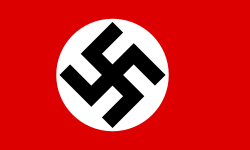
Back مفوضية الرايخ أوستلاند Arabic Рэйхскамісарыят Остланд Byelorussian Райхскамісарыят Остлянд BE-X-OLD Reichskommissariat Ostland Catalan Říšský komisariát Ostland Czech Reichskommissariat Ostland Danish Reichskommissariat Ostland German Ραϊχσκομισαριάτ Όστλαντ Greek Reichskommissariat Ostland Spanish Ostland Estonian
Reichskommissariat Ostland | |||||||||||||||||||||
|---|---|---|---|---|---|---|---|---|---|---|---|---|---|---|---|---|---|---|---|---|---|
| 1941–1945 | |||||||||||||||||||||
| Anthem: Horst-Wessel-Lied ("The Horst Wessel Song") | |||||||||||||||||||||
 Reichskommissariat Ostland in 1942 | |||||||||||||||||||||
| Status | Reichskommissariat of Germany | ||||||||||||||||||||
| Capital | Riga | ||||||||||||||||||||
| Common languages |
| ||||||||||||||||||||
| Religion | |||||||||||||||||||||
| Government | Civil administration | ||||||||||||||||||||
| Reichskommissar | |||||||||||||||||||||
• 1941–1944 | Hinrich Lohse | ||||||||||||||||||||
• 1944–1945 | Erich Koch | ||||||||||||||||||||
| Historical era | World War II | ||||||||||||||||||||
| 22 June 1941 | |||||||||||||||||||||
• Established | 17 July 1941 | ||||||||||||||||||||
• Implement civil administration | 25 July 1941 at 12:00 | ||||||||||||||||||||
| 5 December 1941 | |||||||||||||||||||||
| 1 April 1944 | |||||||||||||||||||||
• Soviets reoccupied Riga | 13 October 1944 | ||||||||||||||||||||
• Formally dissolved | 21 January 1945 | ||||||||||||||||||||
• Surrender of Courland Pocket | 10 May 1945 | ||||||||||||||||||||
| Currency | Reichskreditkassenscheine (de facto) | ||||||||||||||||||||
| |||||||||||||||||||||
| Today part of | |||||||||||||||||||||
The Reichskommissariat Ostland (RKO; lit. 'Reich Commissariat of Eastland')[a] was an administrative entity of the Reich Ministry for the Occupied Eastern Territories of Nazi Germany from 1941 to 1945. It served as the German civilian occupation regime in Lithuania, Latvia, Estonia, and the western part of the Byelorussian SSR during the Eastern Front of World War II.
Ostland was established after the success of the Wehrmacht's Baltic operation and an initial period of military administration by Army Group North Rear Area based on the equivalent Reichskommissariat Baltenland in German planning documents.[1] It was divided into Generalbezirk Estland (Estonia), Generalbezirk Lettland (Latvia), Generalbezirk Litauen (Lithuania), and Generalbezirk Weißruthenien (Belarus) each with its own Nazi collaborationist government and Auxiliary Police under the control of a German Generalkommissar. Hinrich Lohse served as the Reichskommissar from 1941 to 1944 and Erich Koch from 1944 to 1945.
Ostland was part of the Generalplan Ost which included the genocide of the Jewish population, the deportation and murder of Jews from Central Europe, the expulsion and murder of some of the native non-Jewish population, the settlement of Germanic peoples, and the Germanization of the rest. The SS and their Einsatzgruppen A and B, with active participation of the Order Police battalions and local Auxiliary Police forces, killed over a million Jews and others in the territory.[2][3]
In the course of 1943 and 1944, the Red Army recaptured most of Ostland in their advance westwards, and many of its institutions were dissolved in late 1944 and early 1945. German forces including the rump administration of Ostland held out in the Courland Pocket until 10 May 1945, two days after the German surrender.
Cite error: There are <ref group=lower-alpha> tags or {{efn}} templates on this page, but the references will not show without a {{reflist|group=lower-alpha}} template or {{notelist}} template (see the help page).
- ^
Kay, Alex J. (2006). "Guidelines for Special Fields (13 March 1941)". Exploitation, Resettlement, Mass Murder: Political And Economic Planning for German Occupation Policy in the Soviet Union, 1940–1941. Berghahn Books. p. 129. ISBN 1845451864. Retrieved 2013-06-25.
In the week following [...] 2 May [1941], Alfred Rosenberg produced three papers relating to his preparations for the future administration in the occupied East. The first, dated 7 May, was entitled 'Instruction for a Reich Commissar in the Ukraine'. [...] The second, produced a day later, was its equivalent for the area of Baltenland (Baltic land), as the Baltic States and Belarus were at this stage being collectively referred to. In his drafting of the paper, Rosenberg crossed through 'Balten' and replaced it with 'Ost'. [...] The designation 'Ostland' would stick.
- ^ Pohl, Reinhard (November 1998). "Reichskommissariat Ostland: Schleswig-Holsteins Kolonie" [Reichskommissariat Ostland: Schleswig-Holstein's Colony] (PDF). Gegenwind. Gegenwind-Sonderheft: Schleswig-Holstein und die Verbrechen der Wehrmacht (in German). Gegenwind, Enough is Enough, and anderes lernen/Heinrich-Böll-Stiftung Schleswig-Holstein. pp. 10–12. Retrieved 2014-03-27.
Vom Einmarsch im Juni 1941 bis Ende Januar 1942, der Niederlage vor Moskau, töteten die deutschen Truppen im 'Ostland' etwa 330.000 Juden, 8359 'Kommunisten', 1044 'Partisanen' und 1644 'Geisteskranke'. [...] Die erste Tötungswelle hatten ungefähr 670.000 Juden überlebt, dazu kamen im Winter 1941/42 noch 50.000 deportierte Juden aus dem Reichsgebiet, die in die Ghettos von Minsk und Riga kamen. [...] Anfang 1943 begann die zweite große Tötungswelle, der mindestens 570.000 Jüdinnen und Juden zum Opfer fielen. [...] Die letzten 100.000 Juden kamen in Konzentrationslager in Kauen, Riga-Kaiserwald, Klooga und Vaivara, sie wurden 1944 beim Heranrücken der Roten Armee liquidiert.
[From the invasion in June 1941 until the end of January 1942 (the defeat at Moscow) German troops in 'Ostland' killed approximately 330,000 Jews, 8359 'Communists', 1044 'partisans' and 1644 'mentally ill' people. [...] About 670,000 Jews survived the first wave of killings; in the winter of 1941/1942 another 50,000 Jews deported from the Reich area joined these and ended up in the ghettos of Minsk and Riga. [...] At the beginning of 1943 the second great wave of killings began, in which at least 570,000 Jews became victims. [...] The final 100,000 Jews entered the concentration camps in Kauen [= Kaunas], Riga-Kaiserwald, Klooga and Vaivara; they were liquidated in 1944 with the advance of the Red Army.] - ^ Czesław Madajczyk, ed. (1994). Vom Generalplan Ost zum Generalsiedlungsplan. Munich: Saur, p. XI.
© MMXXIII Rich X Search. We shall prevail. All rights reserved. Rich X Search

